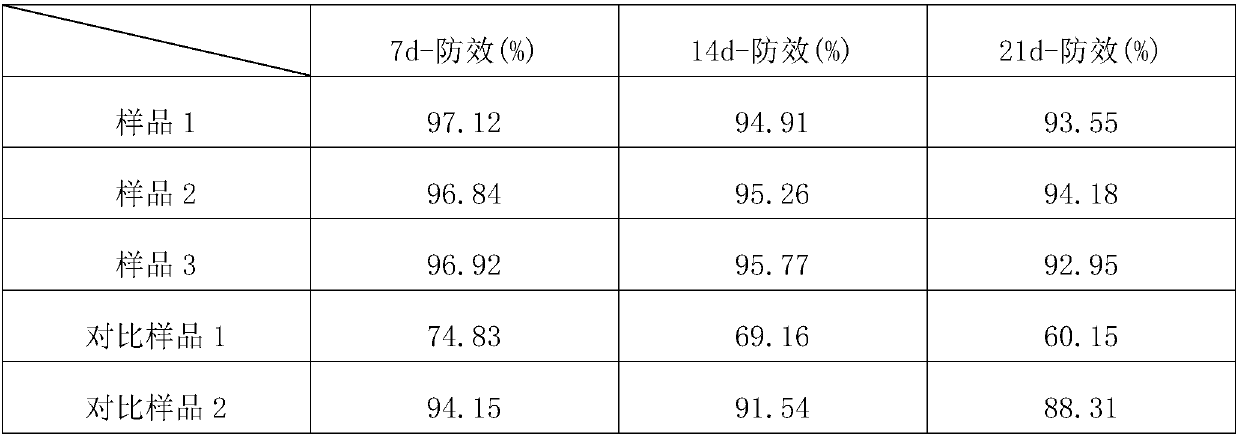Pesticide for preventing and treating rice sheath blight and method for preparing pesticide
A rice sheath blight and pesticide technology, applied in the field of pesticides, can solve problems such as affecting the normal growth of rice, and achieve the effect of easy operation
- Summary
- Abstract
- Description
- Claims
- Application Information
AI Technical Summary
Problems solved by technology
Method used
Image
Examples
Embodiment 1
[0018] A pesticide for preventing and treating rice sheath blight, which is prepared from the following raw materials: annual sheath, ivy, sorrel, motherwort, white orchid, cocklebur, pokeweed, and an emulsifier; The pesticides for sheath blight include: 100 parts of annual capes, 25 parts of ivy, 25 parts of sorrel, 15 parts of motherwort, 10 parts of white orchid, 10 parts of cocklebur, 10 parts of pokeweed, 5 parts of emulsifier; selected from calcium dodecylbenzenesulfonate.
[0019] A method for preparing the pesticide for preventing and treating rice sheath blight, characterized in that it comprises the following steps:
[0020] S1. Take annual flax, ivy, sorrel, motherwort, white orchid, cocklebur, and pokeweed and put them into a drying room for drying until the water content is 8%, take them out, chop them up, and mix them uniformly to obtain medicinal raw materials ;
[0021] S2. Take the drug raw material, add the extract according to 20 times the weight of the dr...
Embodiment 2
[0024] A pesticide for preventing and treating rice sheath blight, which is prepared from the following raw materials: annual sheath, ivy, sorrel, motherwort, white orchid, cocklebur, pokeweed, and an emulsifier; Pesticides for sheath blight include: 110 parts of annual capes, 28 parts of ivy, 27 parts of sorrel, 18 parts of motherwort, 13 parts of white orchid, 14 parts of cocklebur, 14 parts of pokeweed, 7 parts of emulsifier; selected from tenyl polyglucosides.
[0025] A method for preparing the pesticide for preventing and treating rice sheath blight, characterized in that it comprises the following steps:
[0026] S1. Take annual flax, ivy, sorrel, motherwort, white orchid, cocklebur, and pokeweed and put them into a drying room for drying until the moisture content is 9%, take them out, chop them up, and mix them uniformly to obtain medicinal raw materials ;
[0027] S2. Take the drug raw material, add the extract according to 23 times the weight of the drug raw mater...
Embodiment 3
[0031] A pesticide for preventing and treating rice sheath blight, which is prepared from the following raw materials: annual sheath, ivy, sorrel, motherwort, white orchid, cocklebur, pokeweed, and an emulsifier; The pesticides for sheath blight include: 120 parts of P. chinensis, 30 parts of ivy, 30 parts of sorrel, 20 parts of motherwort, 15 parts of white orchid, 15 parts of cocklebur, 15 parts of pokeweed, 8 parts of emulsifier; selected from alkylphenol polyoxyethylene ethers.
[0032] A method for preparing the pesticide for preventing and treating rice sheath blight, characterized in that it comprises the following steps:
[0033] S1. Take annual flax, ivy, sorrel, motherwort, white orchid, cocklebur, and pokeweed and put them into a drying room for drying until the water content is 10%, take them out, chop them up, and mix them uniformly to obtain the drug raw material ;
[0034] S2. Take the drug raw material, add the extract according to 25 times the weight of the ...
PUM
 Login to View More
Login to View More Abstract
Description
Claims
Application Information
 Login to View More
Login to View More - R&D
- Intellectual Property
- Life Sciences
- Materials
- Tech Scout
- Unparalleled Data Quality
- Higher Quality Content
- 60% Fewer Hallucinations
Browse by: Latest US Patents, China's latest patents, Technical Efficacy Thesaurus, Application Domain, Technology Topic, Popular Technical Reports.
© 2025 PatSnap. All rights reserved.Legal|Privacy policy|Modern Slavery Act Transparency Statement|Sitemap|About US| Contact US: help@patsnap.com

